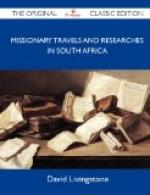Chapter 6.
Kuruman—Its fine Fountain—Vegetation of the District—Remains of ancient Forests—Vegetable Poison—The Bible translated by Mr. Moffat—Capabilities of the Language—Christianity among the Natives—The Missionaries should extend their Labors more beyond the Cape Colony—Model Christians—Disgraceful Attack of the Boers on the Bakwains—Letter from Sechele—Details of the Attack—Numbers of School-children carried away into Slavery—Destruction of House and Property at Kolobeng—The Boers vow Vengeance against me—Consequent Difficulty of getting Servants to accompany me on my Journey—Start in November, 1852—Meet Sechele on his way to England to obtain Redress from the Queen—He is unable to proceed beyond the Cape—Meet Mr. Macabe on his Return from Lake Ngami—The hot Wind of the Desert—Electric State of the Atmosphere—Flock of Swifts—Reach Litubaruba—The Cave Lepelole—Superstitions regarding it—Impoverished State of the Bakwains—Retaliation on the Boers—Slavery—Attachment of the Bechuanas to Children—Hydrophobia unknown—Diseases of the Bakwains few in number—Yearly Epidemics—Hasty Burials—Ophthalmia—Native Doctors—Knowledge of Surgery at a very low Ebb—Little Attendance given to Women at their Confinements—The “Child Medicine”—Salubrity of the Climate well adapted for Invalids suffering from pulmonary Complaints.
The permanence of the station called Kuruman depends entirely on the fine ever-flowing fountain of that name. It comes from beneath the trap-rock, of which I shall have to speak when describing the geology of the entire country; and as it usually issues at a temperature of 72 Deg. Fahr., it probably comes from the old silurian schists, which formed the bottom of the great primeval valley of the continent. I could not detect any diminution in the flow of this gushing fountain during my residence in the country; but when Mr. Moffat first attempted a settlement here, thirty-five years ago, he made a dam six or seven miles below the present one, and led out the stream for irrigation, where not a drop of the fountain-water ever now flows. Other parts, fourteen miles below the Kuruman gardens, are pointed out as having contained, within the memory of people now living, hippopotami, and pools sufficient to drown both men and cattle. This failure of water must be chiefly ascribed to the general desiccation of the country, but partly also to the amount of irrigation carried on along both banks of the stream at the mission station. This latter circumstance would have more weight were it not coincident with the failure of fountains over a wide extent of country.




